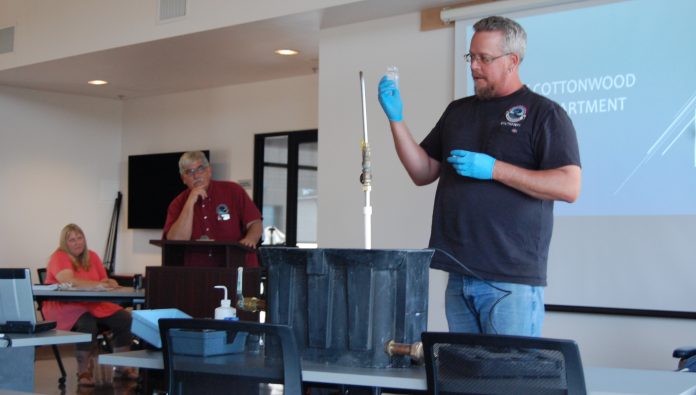On May 24, the Arizona Attorney General’s office announced an indictment against Hans Burnett, a former foreman at the city of Cottonwood water testing laboratory, which also handles water for Verde Village and Clarkdale, stating he had deliberately and knowingly fabricated test results on the water quality of Cottonwood.
It was the latest in a nearly yearlong scandal that first came to light when the Arizona Department of Environmental Quality opened an investigation in July 2017 and had already led to the city outsourcing its water testing process to a lab in Phoenix.
The city of Cottonwood, the water testing utility and ADEQ stated there was no evidence the water had been contaminated and that the test issue was solely based on paperwork. Nevertheless, several Cottonwood residents spoke up at the June 5 Cottonwood City Council meeting, demanding accountability and reassurances that the water system was safe.
The city made efforts to assuage those concerns in the past weeks. Employees from the water division of the Cottonwood Utility Department held public forums on June 7 and 14 at the Riverfront Water Reclamation Facility to answer questions from the public and give more details about how the water system works.
“It’s an imperfect system. We do the best we can,” said Roger Biggs, utilities manager for the water and billing divisions, at the June 14 meeting. He highlighted that perfectly pure water is “a laboratory creation” and that in any system, the water is affected by its environment, but that this does not mean that the water is unsafe.
“We made a mistake,” Biggs said. “We screwed up the sample, then we screwed up the paperwork derived from the sample. But it’s not a reflection on the water.”
The utility employees focused on the complexity of the water system, both as a means of explaining how a mistake in testing could happen, but also to explain how difficult it would be for a large-scale contamination to happen to water throughout the city.
“When people think of the city of Cottonwood, they think of one water system,” said Debbie Breitkreutz, the water utility’s administrator for regulatory compliance, safety and education. “It’s actually six different water systems, each servicing different parts of the area.”
Breitkreutz went over the geography of the six water systems, which each handle different areas like parts of the Verde Village or Clarkdale, and the testing schedules for each of them. According to Breitkreutz, each of the water systems is tested frequently for microbiological samples, disinfection residual and disinfection byproducts like total trihalomethanes and haloacetic acids identified by the Environmental Protection Agency, arsenic, and lead and copper samples. These tests are administered on different schedules, ranging from monthly to triennially.
“We’ve taken 7,000 coliform samples since we’ve owned the water company,” Biggs said, referring to the bacteria that tests look for to find evidence of other contaminants. “We’ve had one come back positive for E. coli. The source for E. coli was in the house. It wasn’t in the water.”
Mike Traynor, Cottonwood’s utility operations manager, demonstrated the testing procedure for the water system, emphasizing how thorough the process is but also how easy it is for something to go wrong via human error.
“It’s a common mistake that people get lazy, their hands are full, they get distracted,” Traynor said. “There’s a lot of ways to contaminate a sample.”
Many in the audience expressed continued concern about the water testing process, including complaints that notifications do not always come to the public in a timely fashion.
But city employees said they feel they made some progress in allowing Cottonwood residents to feel safe with their water system.
“This was a good meeting,” Biggs said after the June 14 meeting. “We had an opportunity to explain how complicated the system is. There’s a lot of misconceptions. People see a well site and think that’s the well. But it’s one of 21 wells.”
Breitkreutz said she views the ordeal as an opportunity to improve the city’s information and education systems in regard to water testing, and said she would seek to put up more general information for the public on the water utility’s website.
“We’re trying to get the information out there to people,” she said. “We want them to be informed about what’s going on in our systems.”
Jon Hecht can be reached at 634-8551 or email jhecht@larsonnewspapers.com



